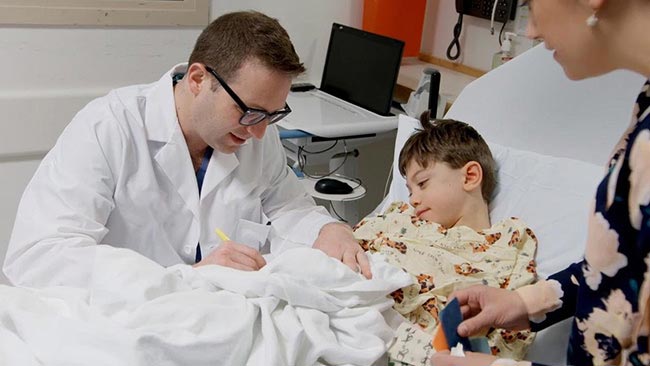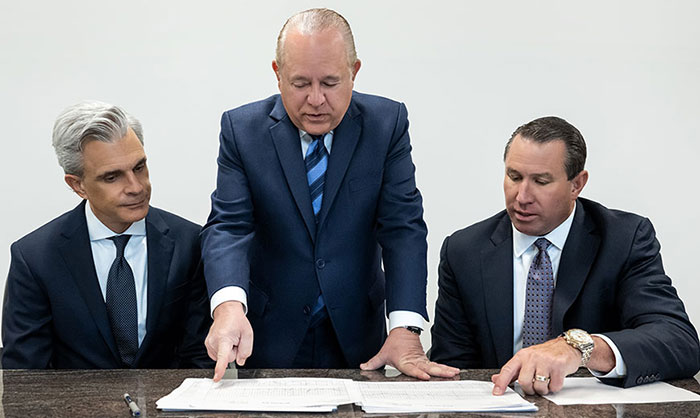What is Fetal Bradycardia?
Certain heart rate changes in an unborn baby are critical indicators of the baby’s health condition. The general consensus in the medical community is that a fetal heart rate (FHR) in the range of 120-160 beats per minute (bpm) is considered normal. Anything exceeding this range should be recognized as a fast heart rate (“tachycardia”), and anything below this range should be recognized as a slow heart rate (“bradycardia”). Too slow or too fast heart rates in unborn babies may pose a serious health risk.
Fetal Heart Rate Strips
Normal Fetal Heart Rate Strip
Tachycardia Fetal Heart Rate Strip
Bradycardia Fetal Heart Rate Strip
Bradycardia is the medical term to describe an abnormally low heart rate. Clinically, an unborn baby’s sustained baseline heart rate below 120 bpm is called fetal bradycardia. Fetal bradycardia is a type of arrhythmia (slow and irregular heart rhythm), which could affect the health of the fetus during pregnancy and is one of the most common indicators that the baby is suffering from fetal distress. The lower the baby’s heart rate during pregnancy, the higher the risk of a birth injury including hypoxic-ischemic encephalopathy (HIE).
In modern day medicine the baby’s heart rate prior to delivery can be monitored using an electronic fetal monitor that will show the number of beats per minute (bpm) of the baby’s heart. From the strips and screen of the monitor, obstetricians and nurses can determine if a baby is suffering from bradycardia.
Degrees of Severity in Fetal Bradycardia
- Heart rate 100 to 120 bpm: Bradycardia in this range with normal variability is commonly seen in post-term pregnancy (lasting more than 42 weeks) as well as in fetuses with transverse (baby is positioned horizontally instead of vertically across the uterus) or occiput posterior (baby is head down but facing the abdomen) presentations.
- Heart rate 90 to 100 bpm: A fetus with this degree of bradycardia has a much higher risk of suffering from hypoxia and ischemia that can lead to a birth injury. This non-reassuring pattern of bradycardia is usually seen in fetuses with myocardial conduction defects (inherited heart rhythm disturbance) or other congenital heart abnormalities or that are suffering from prolonged hypoxia.
- Heart rate 80 to 90 bpm or lower: The chances of miscarriage are very high in babies with a heart rate of less than 90 bpm. Bradycardia of less than 80 bpm which prolongs for at least three minutes is an indication of severe hypoxia and is likely to result in a severe hypoxic ischemic injury.

Causes of Fetal Bradycardia
A variety of conditions may cause fetal bradycardia. One of the causes is certain types of medications that may have been administered to the mother. Research shows that beta-blockers to treat heart conditions in pregnant women may lead to fetal bradycardia. The use of labor inducing drugs such as Cytotec and Pitocin may also contribute to this condition in the fetus. Other causes of fetal bradycardia may include:
- Uterine rupture: This condition usually occurs at the site of a previous caesarian section, when there is a tear in the wall of the uterus
- Fetal Distress: Is the general term used when baby is suffering from any ailment causing reduced or lack of oxygen (hypoxia or anoxia)
- Placental abruption: This occurs when the placenta gets separated from the uterine wall
- Umbilical cord complications: These include conditions when the umbilical cord is wrapped around the neck of the baby, when it is compressed, and when it precedes the fetus through the birth canal
- Prolonged Labor: when this occurs a baby’s fetal oxygen reserves may be depleted
- Excessively large or long contractions (“Tachysystole”) that adversely affect the baby’s oxygen levels
- Uteroplacental insufficiency: This condition occurs when the blood flow to the placenta is inadequate
- Oligohydramnios: When the amniotic fluid is too little
- Polyhydramnios: When the amniotic fluid is in excess
- Breech position: When instead of head-down, the baby is in a buttocks-first or foot-first position
- Size of the baby: When the baby’s weight is more than 9 lbs. or when the baby’s head is excessively large and may not go through the pelvis
- Maternal connective tissue disorder: Connective tissue disorders, such as systemic lupus erythematosus (SLE) in the mother may be associated with fetal bradycardia
It is critical that all babies be monitored during the labor and delivery process with electronic fetal monitoring equipment to detect whether or not bradycardia is occurring. When the cause of fetal bradycardia cannot be determined or reversed or it persists, immediate delivery is usually recommended including by emergency c-section.
Potential Consequences of Bradycardia in Babies
Fetal bradycardia that is not diagnosed or corrected well in time may lead to serious long-term effects for the baby. The fetal or neonatal outcomes may include nerve damage, brain damage, hypoxia or anoxia, paralysis, cerebral palsy, and in some instances even death.

The consequences will depend on factors such as delay in clinical diagnosis and treatment, congenital heart defects, and the baby’s gestational age. Children who survive prolonged bradycardia may still be at the risk of living with a pacemaker immediately after birth or at some later stage in life.
Failure of medical providers to perform continuous fetal heart rate monitoring, failure to notice abnormalities in heart rate, incorrect installation of the FHR monitoring device, misreading of the fetal heart rate strips, and incorrect or delayed treatment when fetal distress is detected are some of the preventable factors that could make a critical difference to the baby’s health status and survival.
Types of Fetal Bradycardia
Fetal bradycardia is clinically classified into several types, including sinus bradycardia, blocked premature atrial contractions, and atrioventricular heart block. The medical team can diagnose the specific fetal bradycardia based on the echocardiogram (ECHO) measurements and atrioventricular (AV) conduction patterns.
“Atria” are the heart’s upper chambers and “ventricles” are the lower chambers. When electrical signals that produce heartbeat do not travel normally from the upper to the lower heart chambers, the condition is known as a heart block.
Sinus Bradycardia
- Transient Sinus Bradycardia: Brief bradycardia episodes lasting one to two minutes that are often physiologic and occur because of increased vagus nerve stimulation (VNS) are termed as transient sinus bradycardia. (Vagus nerve in the nervous system controls the heartbeat.) This condition is typically observed in second trimester when the fetal nervous system is relatively immature.
- New-onset Sinus Bradycardia: This condition may indicate urgent delivery because of severe hypoxia and fetal distress. New-onset sinus bradycardia may occur as a result of uterine rupture, placental abruption, umbilical cord prolapse, and fetal hemorrhage.
- Sinus Node Dysfunction: Sinus node is located in the right upper heart chamber, and it controls the heart rhythm. Sinus node dysfunction may occur because of a mal-positioned sinus node which functions at a slow rate (generally between 80 to 120 bpm). This condition is typically seen in babies with structural heart disease, which may disturb the node location.
Blocked Premature Atrial Contractions
When ectopic beats (skipped or extra heartbeats) prematurely arise from a location other than the sinus node, the fetal heart arrhythmia may be described as blocked premature atrial contractions. The “missed” heartbeats occurring from this condition could manifest as fetal bradycardia.
The diagnosis may become complex when the ectopic heartbeats occur at a regular rate, resulting in a “regularly irregular” heart rhythm. The medical providers should carefully differentiate these blocked premature atrial heartbeats from AV heart block condition because of the prognosis and treatment will change according to the diagnosis.
Atrioventricular (AV) Heart Block
Congenital heart block (CHB) or AV heart block is one of the commonly occurring forms of fetal bradycardia. This condition can lead to developmental delays or even intrauterine death. Up to 70% of the babies with this condition will require a pacemaker after birth, while the fetal death rate associated with AV heart block is 19%.
Fetal CHB is generally diagnosed during pregnancy at around 18 to 24 gestational weeks using fetal echocardiogram (ECHO) techniques. It’s noteworthy that congenital heart block condition is usually dynamic. Some babies may exhibit a normal or first-degree atrioventricular interval (gap between heartbeats) during initial pregnancy screening, which may later develop into second-degree or complete heart block.
Babies with severe CHB will show a substantially lower heart rate of 50 to 70 bpm. In these cases, the risk of intrauterine death, fetal heart failure, abortion, premature delivery, and edema is high. According to the available clinical evidence, this form of fetal bradycardia is associated with the placental transfer of maternal antibodies (Ro and La antibodies), which causes heart tissue damage.
Diagnosing Fetal Bradycardia
Early diagnosis as well as differential diagnosis (differentiating between two conditions with similar symptoms) is vital to plan for treatment strategies or immediate delivery.

Internal Fetal Monitoring (IFM)
Internal fetal heart monitoring may be used during labor when the cervix is open and the amniotic sac has broken. The medical team will put a thin electrode on the baby’s scalp through the cervix. One end of the electrode is connected to a monitor.
Readings obtained with this method are more reliable, and may prove useful when the external monitoring fails to provide a concrete measurement. Medical providers should monitor the baby’s heart rate and the mother’s uterine contractions together and compare the results for a more accurate diagnosis.
It should be noted though that external fetal monitoring should be instituted as soon as an expectant mother is admitted with labor. This type of electronic fetal monitoring will provide important information about the fetal heart rate during the early stages of labor.
Fetal Echocardiogram

Fetal echocardiogram (fetal echo) can establish the fetal bradycardia diagnosis. It is performed to evaluate the fetal heart structure and diagnose potential structural defects. To identify the specific form of fetal bradycardia, the medical team should assess the cardiac conduction pattern. (The heart conduction system includes conducting fibers and cardiac muscle cells that initiate impulses and conduct them rapidly through the baby’s heart).
Fetal echocardiography is quite similar to an ultrasound test. It helps the medical providers see the heart’s structure and function in the unborn baby. This exam is usually done between 18 and 24 gestational weeks (in the second trimester). The test utilizes sound waves, which produce an “echo” off the fetal heart structures.
An analysis of the echocardiogram images can provide useful information about how the fetal heart was formed and how it is functioning. A detailed look at the fetal echo images will also help the medical team identify any abnormalities in the blood flow through the fetus’s heart (which may cause abnormal heartbeat).
Fetal Ultrasound

A Doppler ultrasonography is a non-invasive test used in the diagnosis of fetal bradycardia. Unlike the standard ultrasound test, which cannot show the blood flow, a Doppler ultrasound can estimate the blood flow through the baby’s blood vessels. It bounces ultrasound waves (high-frequency sound waves) off the circulating RBCs (red blood cells) to indicate congenital heart disease, heart valve defects, and fetal bradycardia.
Diagnosing fetal bradycardia is of paramount importance because it may reveal fetal distress and the need for immediate delivery in order to prevent fetal mortality. Abnormal ultrasound findings (a low fetal heart rate of less than 100-120 bpm) could be an early indicator of potential miscarriage.
Laboratory Studies
Lab tests are essential to diagnose congenital AV heart block type of fetal bradycardia. Two antibody tests in this regard are anti-Ro (SSA) and anti-La (SSB) tests. These tests identify the presence of maternal anti-Ro and anti-La antibodies, which are associated with the third-degree AV block (congenital heart block or CHB), which is a potentially fatal condition for the fetus.
When the mother has a maternal connective tissue disorder, the fetus is a higher risk of developing CHB. Nine out of 10 mothers with fetuses with CHB will test positive for anti-Ro and anti-La antibodies.
Management of Fetal Bradycardia
Antepartum Management
Antepartum (before birth) management should focus on the specific form of fetal bradycardia that has been diagnosed.
- Fetal Sinus Bradycardia: If the condition results from hypoxia or fetal distress, urgent delivery is recommended. If the sinus bradycardia continues after birth (pediatric sick sinus syndrome), use of defibrillators and/or pacemakers, and beta blockers are potential treatments for children.
- Congenital Heart Block (CHB): When a fetal structural heart condition is diagnosed, it is not possible to treat it in-utero. However, certain therapeutic strategies may be used, such as intravenous immunoglobulin (IVIG 400 mg/kg), fluorinated steroids (dexamethasone 4 mg per day), beta blockers (to improve fetal heart rate in cases of CHB), and in recent years, hydroxychloroquine.
Intrapartum Management
When fetal bradycardia occurs, nurses and doctors must immediately take actions to correct the bradycardia. During the period from the onset of labor through the delivery of placenta, if diagnostic tests reveal that the fetal sinus bradycardia has occurred because of fetal distress or hypoxia, then urgent delivery may be clinically indicated.
Intrapartum fetal monitoring is critical to identify bradycardia events that could lead to hypoxic ischemic encephalopathy (HIE), cerebral palsy, brain injury, fetal distress or, even fetal mortality. Continuous electronic fetal monitoring (EFM) and intermittent auscultation (IA, a technique to listen and count the fetal heart rate) can help the medical team decide on an emergent cesarean delivery or an instrumental vaginal delivery. Timely action may reduce the risk of neonatal seizures, cerebral palsy, and neonatal death.
Reading Fetal Heart Rate Strips
One of the challenges with continuous EFM is the absence of standardized methods of interpreting fetal heart rate (FHR) tracings or patterns. The following approach should be considered for more accurate interpretation and effective intrapartum management in case of fetal bradycardia:

- Risk Determination: Determine the clinical risk status of the fetus along with the interpretation of the EFM readings. If the risk status of the baby increases during labor (for instance, a bacterial infection such as chorioamnionitis is diagnosed), the fetal heart monitoring should be changed from intermittent auscultation (IA) to continuous EFM.
- Uterine Contractions: The intrauterine pressure tracing should be reviewed prior to evaluating the fetal tracing in order to correctly interpret decelerations (drop in fetal heart rate). External fetal monitoring may not be adequate to accurately measure the strength of contractions, so an intrauterine pressure catheter should be used to measure the frequency and amplitude of contractions.
- Baseline Rate: The normal FHR baseline rate is considered to be 110 to 160 bpm. If a change in this range continues for at least 10 minutes, a change in baseline rate is said to occur. A baseline of 100 to 110 bpm (mild bradycardia) is associated with post-term babies and with occipitoposterior position (back of the baby’s skull is in the back of the mother’s pelvis). Rates below 100 bpm may be observed in babies with congenital heart defects. A baseline above 160 bpm is called tachycardia.
- Variability: The fetal heart rate will usually show variability of 6 to 25 bpm from the baseline rate. This variation is related to the baby’s central nervous system (CNS), which makes it is a critical indicator to determine the overall fetal status. Variability must be appropriately classified according to the Fetal Heart Rate strips amplitude as: absent, minimal, moderate, or marked variability.
A normal reduction in FHR variability may occur during sleep cycles of 20 to 40 minutes. Certain medications, such as anesthetics, analgesics, or barbiturates may also reduce variability. Variable or late decelerations accompanied by loss of variability will increase the risk of fetal acidosis, if left untreated.
Decelerations
Periodic fluctuations in fetal heart rate, as they correlated to contractions, are called decelerations. If in a 20-minute period, the decelerations occur with at least 50 percent of uterine contractions, they are classified as recurrent. When they occur with lower than 50 percent of uterine contractions, they are classified as intermittent. The reduction in FHR is estimated from the onset to the lowest point of the deceleration.
Management of Abnormal FHR Tracings
When the fetal heart rate measurements are interpreted as abnormal, the medical team should consider urgent interventions, such as change of position, maternal oxygenation, and IV fluid administration. If the continuous electronic fetal monitoring readings are indeterminate, a fetal scalp stimulation test may be used to determine the potential existence of fetal acidosis.
In the event of persistently abnormal FHR tracings, an urgent operative vaginal or cesarean delivery may be recommended. Umbilical cord blood analysis should be performed after such delivery (resulting from abnormal FHR interpretation). This is because the presence of fetal acidosis is one of the key criteria to determine an intrapartum hypoxic-ischemic encephalopathy (HIE) event, which may lead to cerebral palsy.
Summary of Intrapartum Interventions
In the event of abnormal electronic fetal monitoring tracings, the following interventions are recommended:
- Change the maternal position
- Evaluate maternal vital signs (pulse, blood pressure and temperature)
- Discontinue Pitocin (Oxytocin) infusion, if any
- Initiate oxygenation at 6 to 10 LPM (liters per minute)
- Carry out a vaginal examination (to determine umbilical cord prolapsed, vaginal bleeding indicative of placental abruption, or rapid descent of the fetal head)
- Administer IV fluids, if not given already
- Perform fetal scalp stimulation test
- Administer amnioinfusion (instilling of fluid into amniotic cavity) in case of variable and recurrent decelerations
- Assess the need for urgent cesarean or operative vaginal delivery
Postpartum Management
In the postpartum phase (after the delivery) any medical therapy that was started to treat the fetus must be discontinued. If the mother is diagnosed with maternal connective tissue disorder (which may have caused fetal bradycardia) she should be advised to follow up with a rheumatologist or her primary care physician in the postpartum phase for medical care.
Is Your Child’s Fetal Bradycardia the Result of Medical Malpractice?
Parents whose children suffer from cerebral palsy, developmental delays or hypoxic-ischemic encephalopathy caused by fetal bradycardia related complications deserve an answer to how their child developed this condition and whether the complications resulting from it were preventable. Was there evidence on the electronic fetal monitoring strips that the doctors and nurses failed to recognize or respond to? Was there a prolonged bradycardia that required an emergency c-section that was not performed or unreasonably delayed? Our dedicated birth injury lawyers want to help you find those answers and obtain monies necessary to purchase devices that can help improve the quality of your child’s life.
Fetal bradycardia may be an indication of fetal distress or hypoxic-ischemic-encephalopathy (HIE), which is a brain injury resulting from birth asphyxia or oxygen deprivation to the brain. HIE is the leading cause of cerebral palsy.
If your child has been diagnosed with fetal bradycardia related injury, and you suspect this may have been caused in part by medical mistakes, Miller Weisbrod Olesky will thoroughly investigate the facts and hold responsible medical providers accountable by pursuing medical malpractice claims against them. The compensation our clients receive helps them pay for their child’s current and future medical treatment and devices such as defibrillators and/or pacemakers to help child adjust to living with a heart condition, and to be able to pay for these cutting-edge devices.
Sometimes families are hesitant to reach out to a medical malpractice attorney or law firm. Other parents feel overwhelmed by their circumstances and worried that they will not be able to help out in a lawsuit involving their child’s birth injury.
Miller Weisbrod Olesky is different from most law firms.
We provide help NOW.
Many attorneys focus only on pursuing their client’s legal case. At Miller Weisbrod Olesky, we know your child needs help today – not just when your birth injury lawsuit is settled. We have a team focused on helping our clients NOW when they need it most.

We know that children with birth injuries like hypoxic-ischemic encephalopathy (HIE) and cerebral palsy often require intense therapy, specialized medical treatment, and assistive care. The stress of providing for a birth injured child’s needs can be both emotionally and financially draining.
But just ‘knowing’ this is not enough. We act on this knowledge by providing exceptional services to birth-injured children and their families.
While Miller Weisbrod Olesky’s birth injury attorneys aggressively prepare each legal case, another department goes into action to help the families of children we represent. Led by a nurse-attorney, this department acts as a medical case manager for our birth injury clients by:
- Regularly monitoring the child’s medical treatment status,
- Helping facilitate medical treatment and therapy, and
- Arranging transportation and services.
Where necessary, we also help families locate local medical providers specializing in the care and treatment of children who have suffered a birth injury. With Miller Weisbrod Olesky, you’re not just a ‘case’. And that’s important when you’re looking for a lawyer who can help you cope with your child’s needs today.
Please call or email our birth injury attorneys today to get started.
Registered Nurses and Nurse-Attorneys Are a Vital Part of Our Birth Injury Team … and Yours

Most national birth injury law firms will employ one or two nurses to assist the review of cases and medical research. But Miller Weisbrod Olesky offers an unmatched number of nurses and nurse-attorney employees support to both the birth injury attorneys and our clients.
Our team of registered nursing staff and nurse-attorneys bring a deep level of medical and personal insight to every client’s case. Our nursing team includes both an experienced labor and delivery nurse as well as an ICU nurse. Working closely with the rest of the team, they investigate the reasons behind a birth injury and how medical professionals breached their standard of care.
Meet our Legal Nursing Team
Linda Chalk

As a registered nurse, Linda practiced ICU nursing for 44 years while caring for a wide range of patient conditions. She has worked closely with founding partner Les Weisbrod for over 30 years, investigating and pursuing birth injury cases.
Along with DJ Weisbrod, Linda heads up the firm’s birth injury intake, screening, and medical literature research team. She personally screens all potential cases to ensure that medical issues have been addressed before we file lawsuits on behalf of birth-injured children and their families.
DJ Weisbrod

Before joining Miller Weisbrod, DJ practiced as a surgical nurse in various hospital and operative settings. She has been with the firm over 30 years.
DJ directs Miller Weisbrod’s birth injury intake and medical screening team. She has also served as firm founder Les Weisbrod’s trial nurse for all cases involving medical negligence and birth injury.
Linda Cuaderes

Linda Cuaderes is both a registered nurse and a licensed lawyer. Linda works exclusively in Miller Weisbrod’s Birth Injury and Medical Malpractice section. Linda acts as the firm’s patient advocate and liaison with our young clients and their parents.
Linda combines her legal and nursing experience along with her exceptional organizational talent and attention to detail to make sure each child we represent is provided the highest level of medical care and attendant care during the pendency of their case. Linda communicates with our parent clients regularly to monitor their birth injured child’s treatment, provide guidance as to additional care and therapies and when necessary assist them in obtaining specialized medical providers.
Linda was raised in Bartlesville, Oklahoma and completed her Bachelor of Science in Nursing with Honors at the University of Oklahoma. She started as an Oncology Nurse at Presbyterian Hospital in Oklahoma City, quickly becoming the Assistant Head Nurse of the Outpatient Endoscopy Unit. Linda then entered the University of Oklahoma College of Law.
Following graduation, Linda joined Les Weisbrod in the Medical Malpractice Section. After taking time off to raise her three lovely children, Linda returned to Miller Weisbrod and her passion of holding healthcare providers accountable for preventable errors. Linda is active in the American Association for Justice, Texas Trial Lawyers Association, Dallas Trial Lawyers Association, and the Texas Bar Association. Linda is an active member of the Birth Trauma Litigation Group and Medical Negligence Section of the American Association for Justice.
She is admitted to practice before the Texas Supreme Court and routinely works on cases pending throughout the United States. Linda has worked with child victims of birth injury, their parents and other victims of medical malpractice in Texas, New Mexico, Oklahoma, Arkansas, Louisiana, Iowa, Ohio, New York, Alabama, Georgia, Arizona, Utah and Missouri.
Education
- University of Oklahoma - School of Law, 1990, J.D. - Norman, Oklahoma
- University of Oklahoma - School of Nursing, 1985 - Norman, Oklahoma
Areas of Practice
- Birth Injury/Birth Trauma
- Medical Malpractice
Associations & Memberships
- Texas Bar Association
- American Association of Justice
- Texas Trial Lawyers Association
- Dallas Trial Lawyers Association
Kristin Jones

Kristin combines her medical and legal training to provide invaluable, passionate service to parents struggling to care for their birth-injured children.
Families often have questions as they go through the birth injury lawsuit process. Kristin diligently identifies and investigates all medical issues so the birth injury attorneys at Miller Weisbrod can answer those questions Kristin ensures that our birth injured children’s medical records are thoroughly reviewed and organized. Miller Weisbrod’s birth trauma litigation attorneys and medical experts retained by the firm need her services while pursuing justice for our clients.
Kelly Kunkel

Kelly Kunkel was born and raised in Dallas, Texas. She has 15 years’ experience in hospital based High Risk Obstetrics and Labor and Delivery bedside nursing care. Kelly graduated with an Associate’s Degree in Nursing from El Centro College in December of 1990 and received her Bachelor’s Degree in Nursing from West Texas A & M University in 2008; graduating with honors.
In addition, Kelly has over 25 years’ experience in medical malpractice case management and litigation and has worked with David Olesky for over 22 years. After many years of assisting in defending healthcare providers and hospital systems in medical malpractice cases involving complex litigation matters related to birth injury, catastrophic injury and death, Kelly has proudly joined David Olesky in the national birth injury and medical negligence practice at Miller Weisbrod Olesky.
Why Should You Talk with the Knowledgeable Attorneys at Miller Weisbrod Olesky?

The only way to find out if you have a birth injury case is to talk to an attorney who understands birth injuries leading to a delay or failure in developmental milestones including birth injuries that cause cerebral palsy. Many times fetal bradycardia is a preventable birth injury, but it takes a detailed expert review of the facts and circumstances of your child’s birth to determine the birth injury was the result of medical malpractice.
At Miller Weisbrod Olesky, a team of committed attorneys, nurses and paraprofessionals uses our detailed medical negligence case review process to assess your potential birth injury case. We start by learning more about you and your child and the status of meeting/missing developmental milestones. Then we gather medical records to determine what happened before, during, and after your delivery. We call in skilled medical experts who review your records and let us know if they think medical errors could have caused your child’s injuries.
If we feel medical negligence caused or contributed to your child’s injuries, we meet with you to discuss how you can receive compensation from the medical professionals who made the errors.
At no point in our legal intake process will we ask you to pay anything. The medical review of your case and the consultation are free. We only receive payment when you do.



